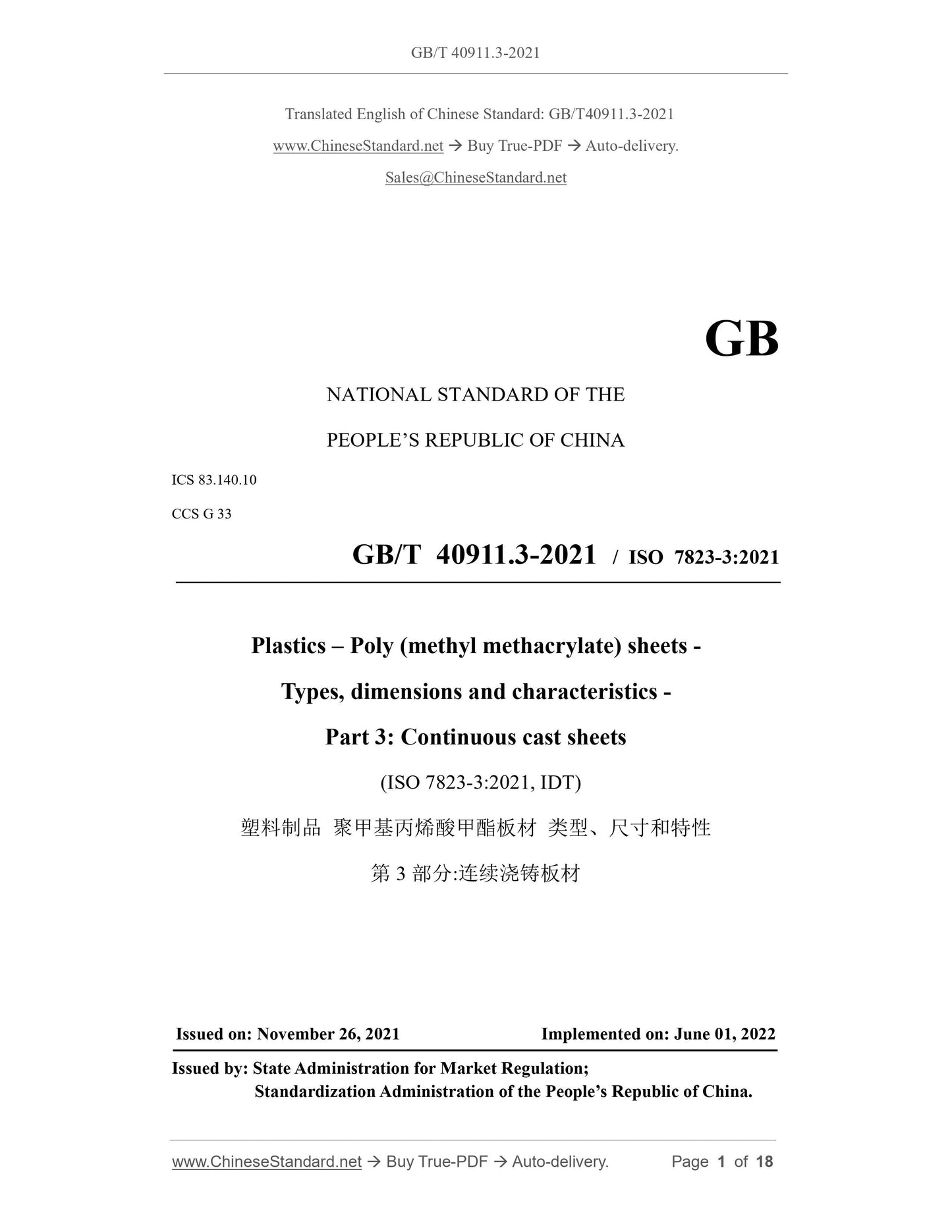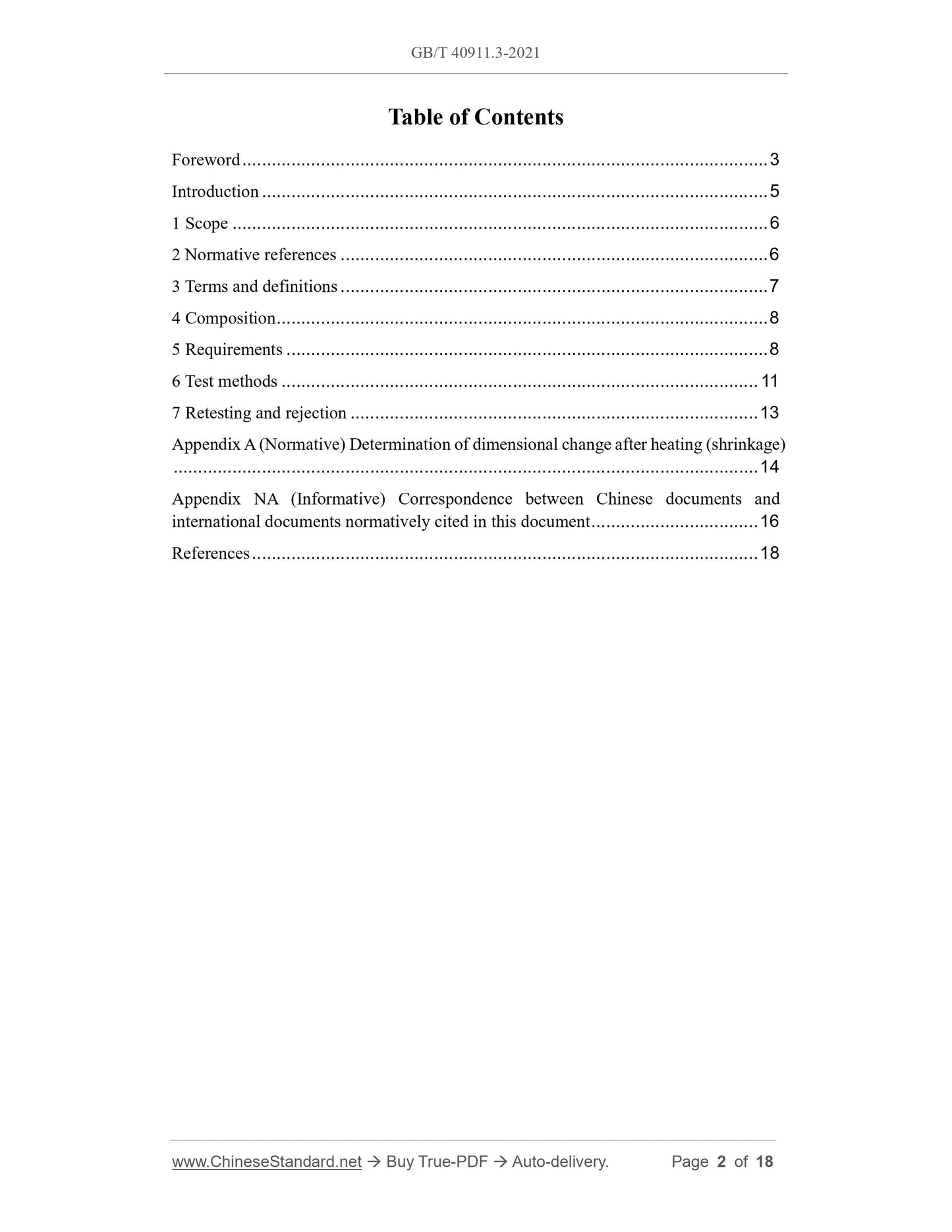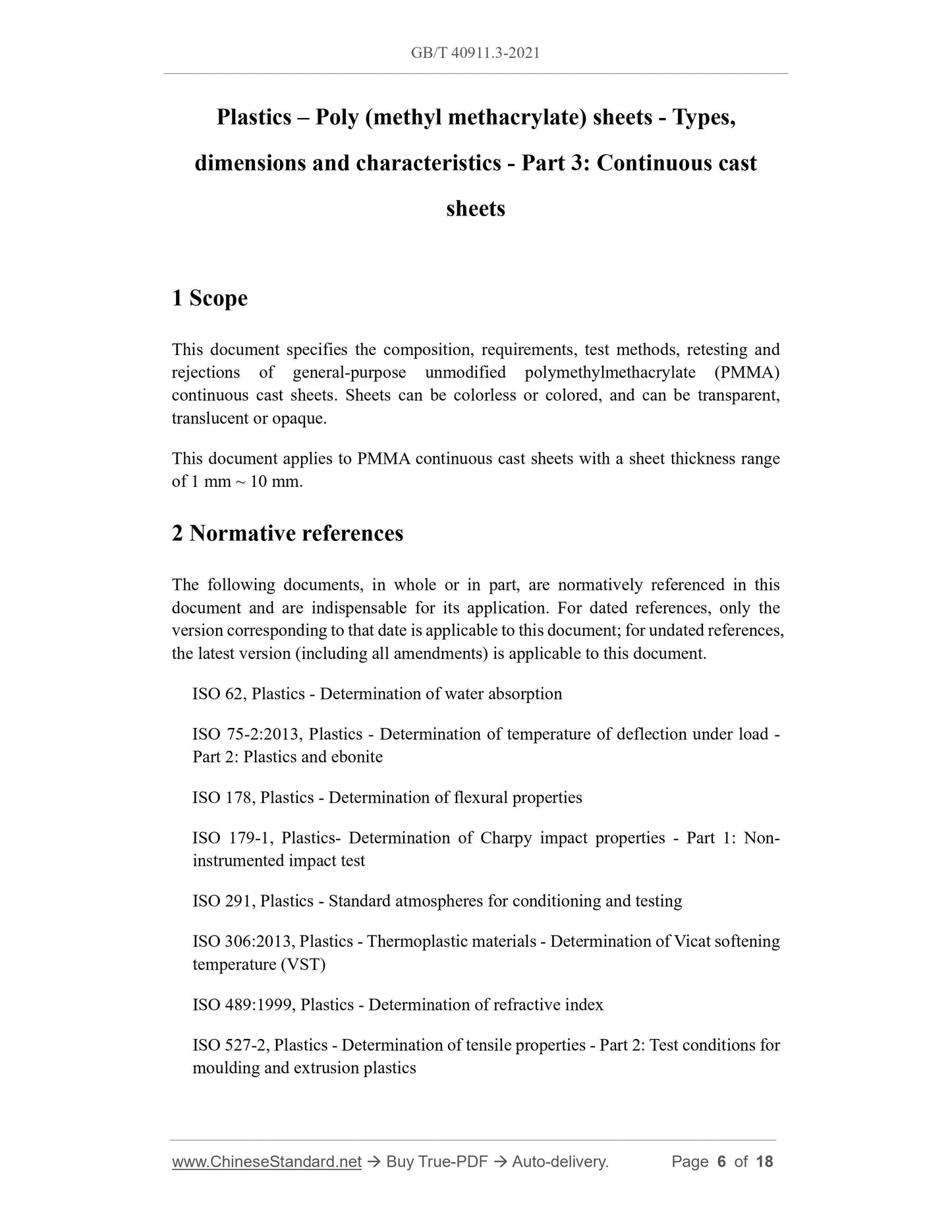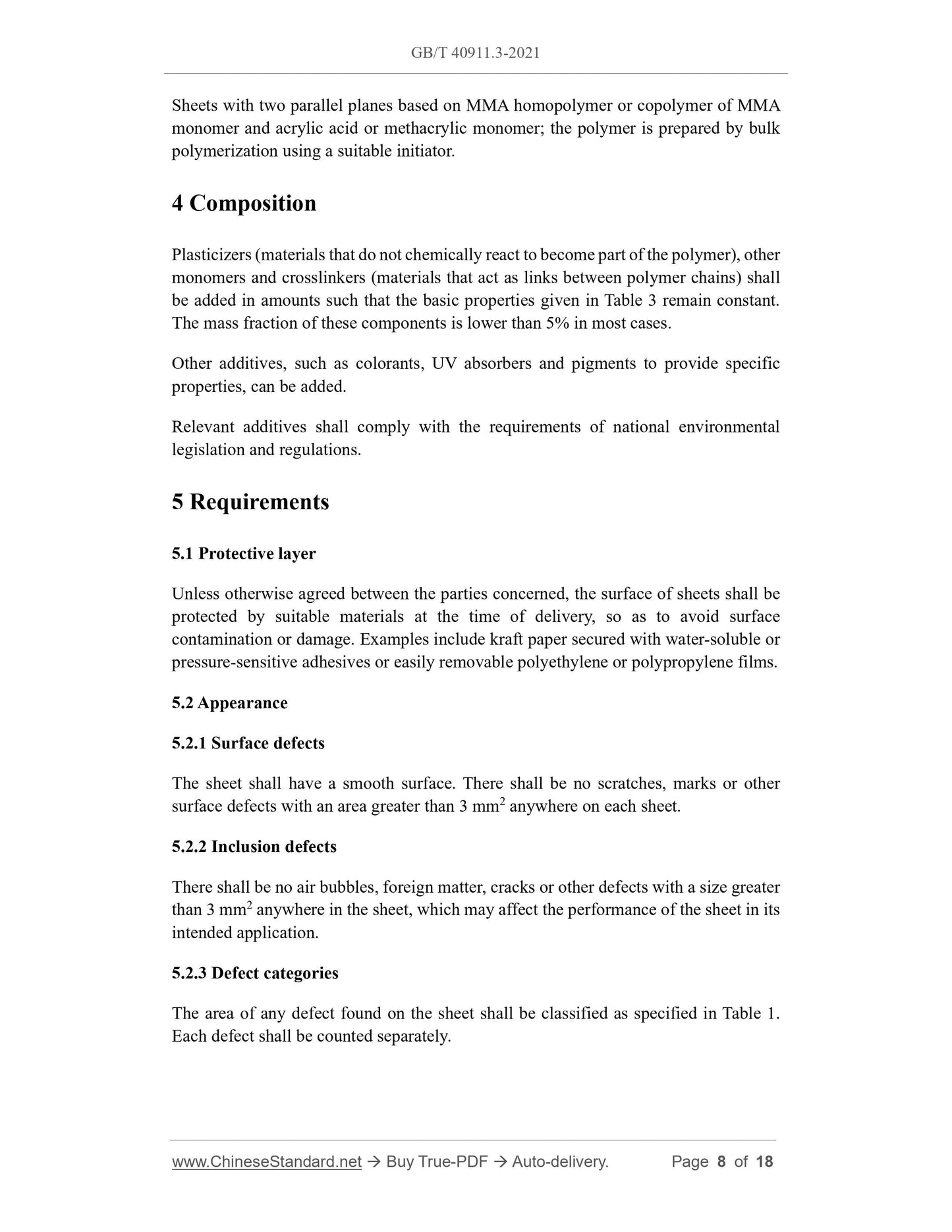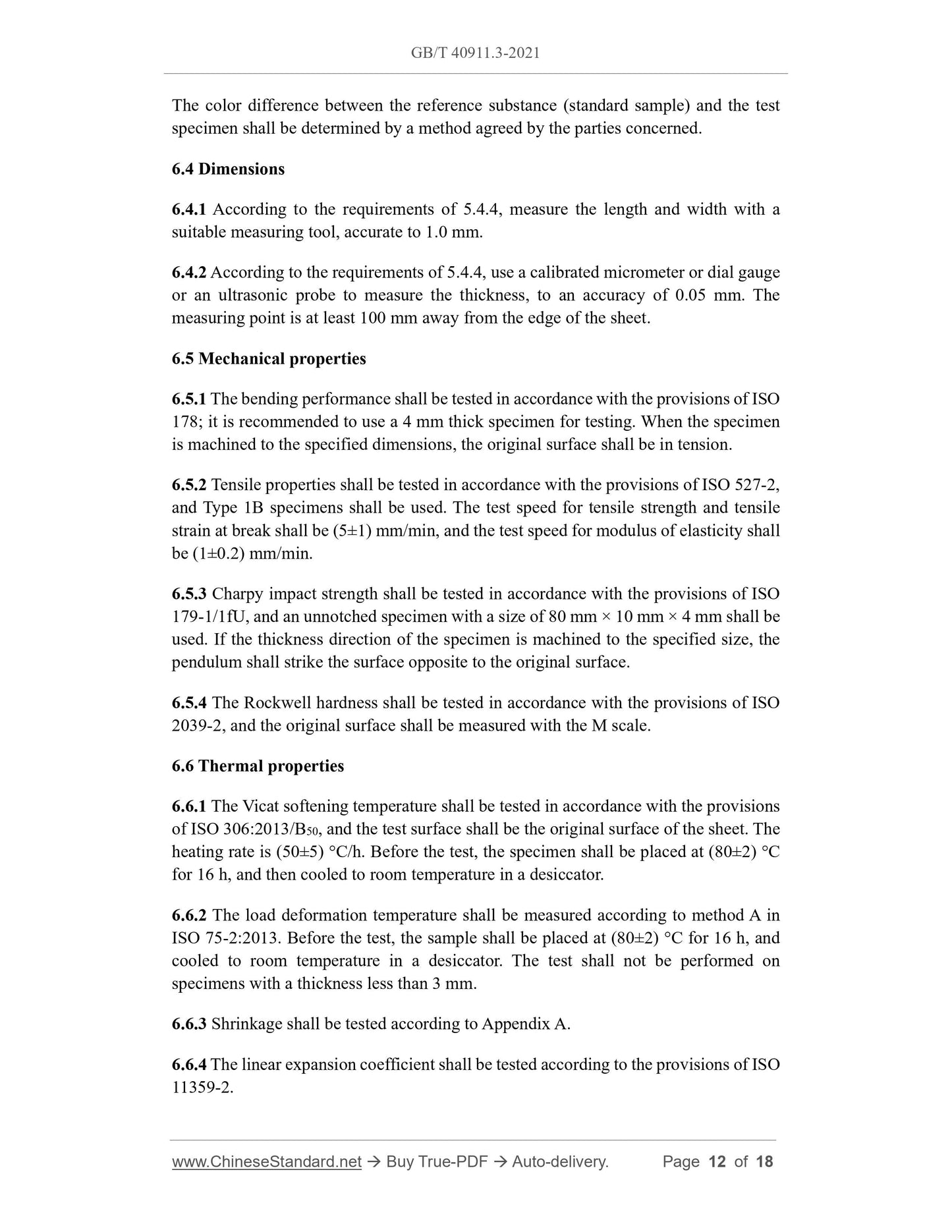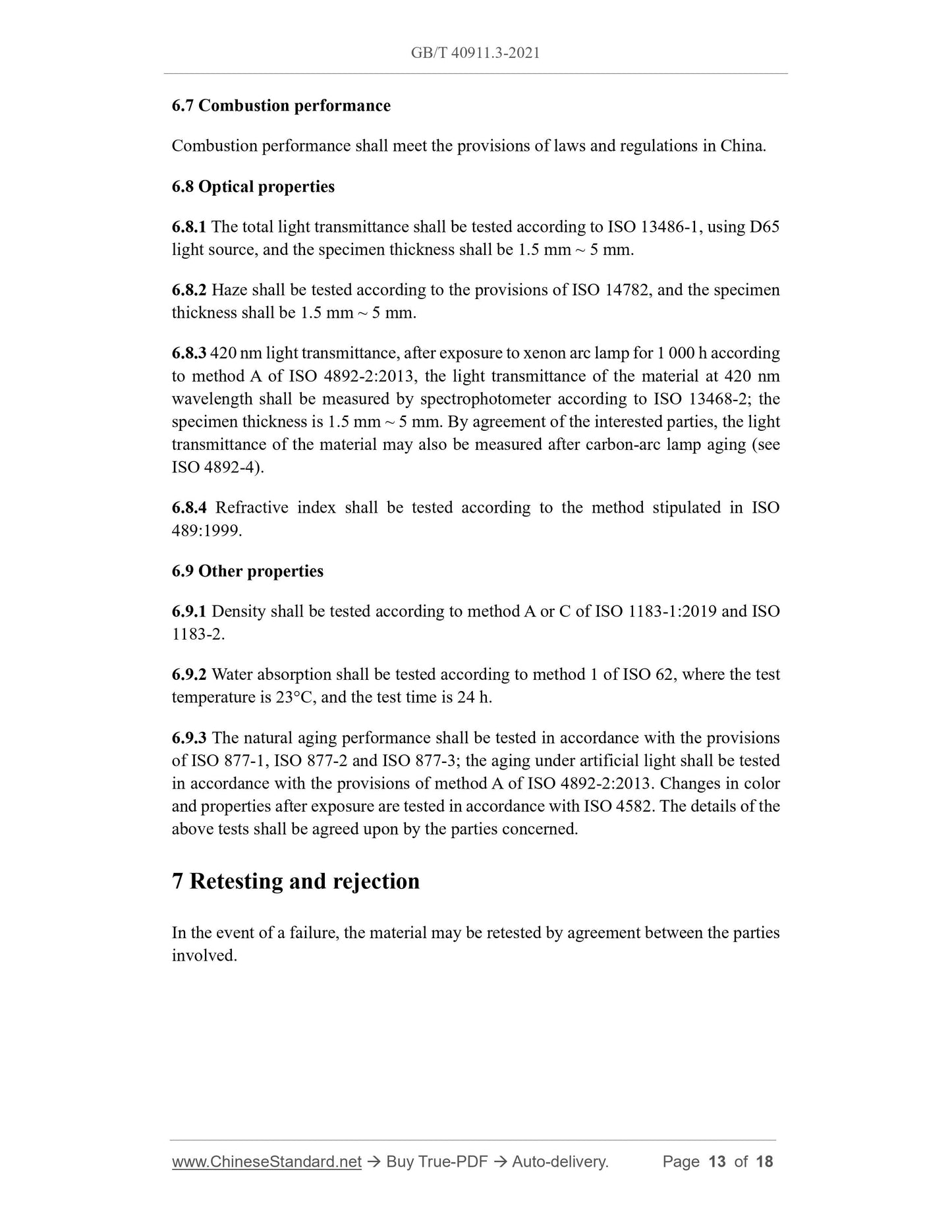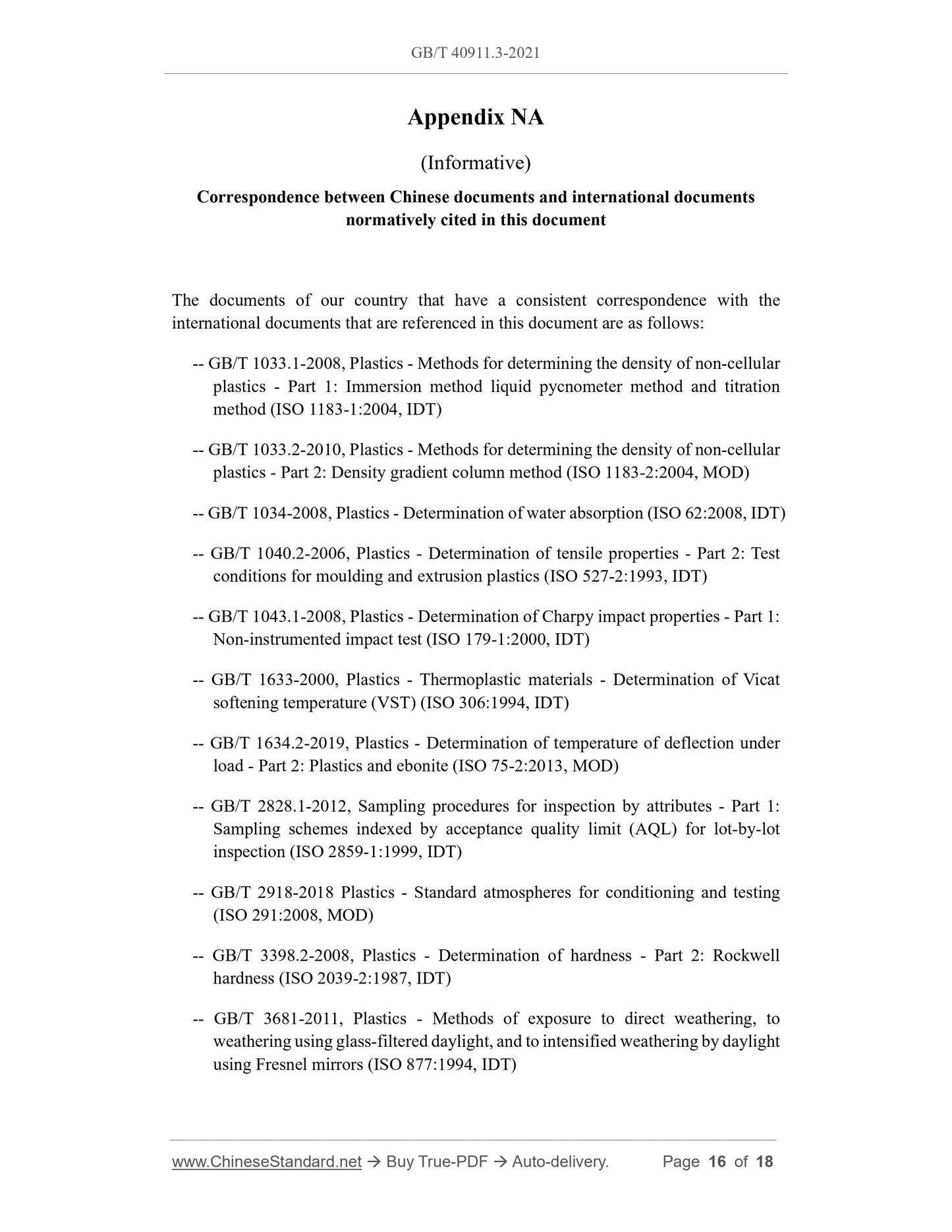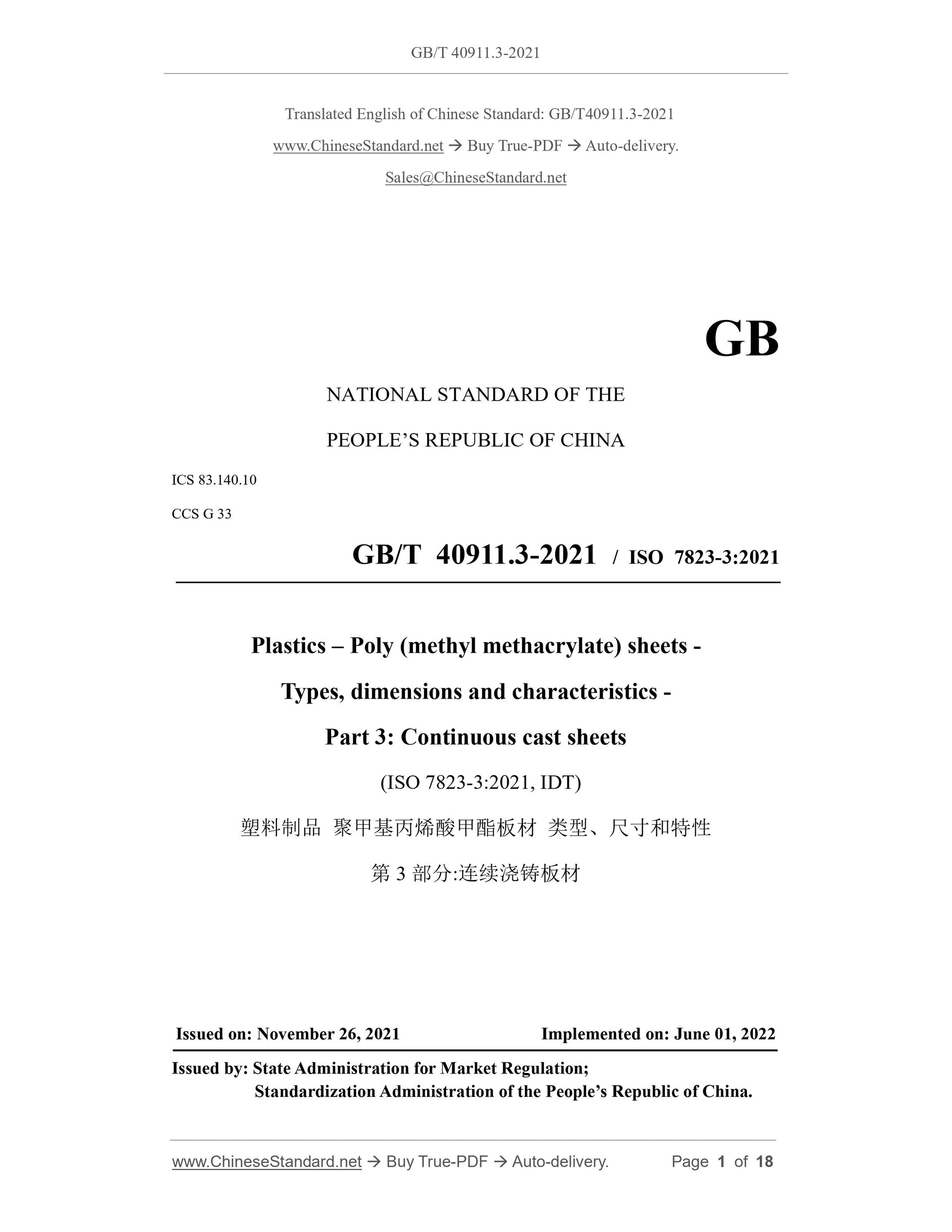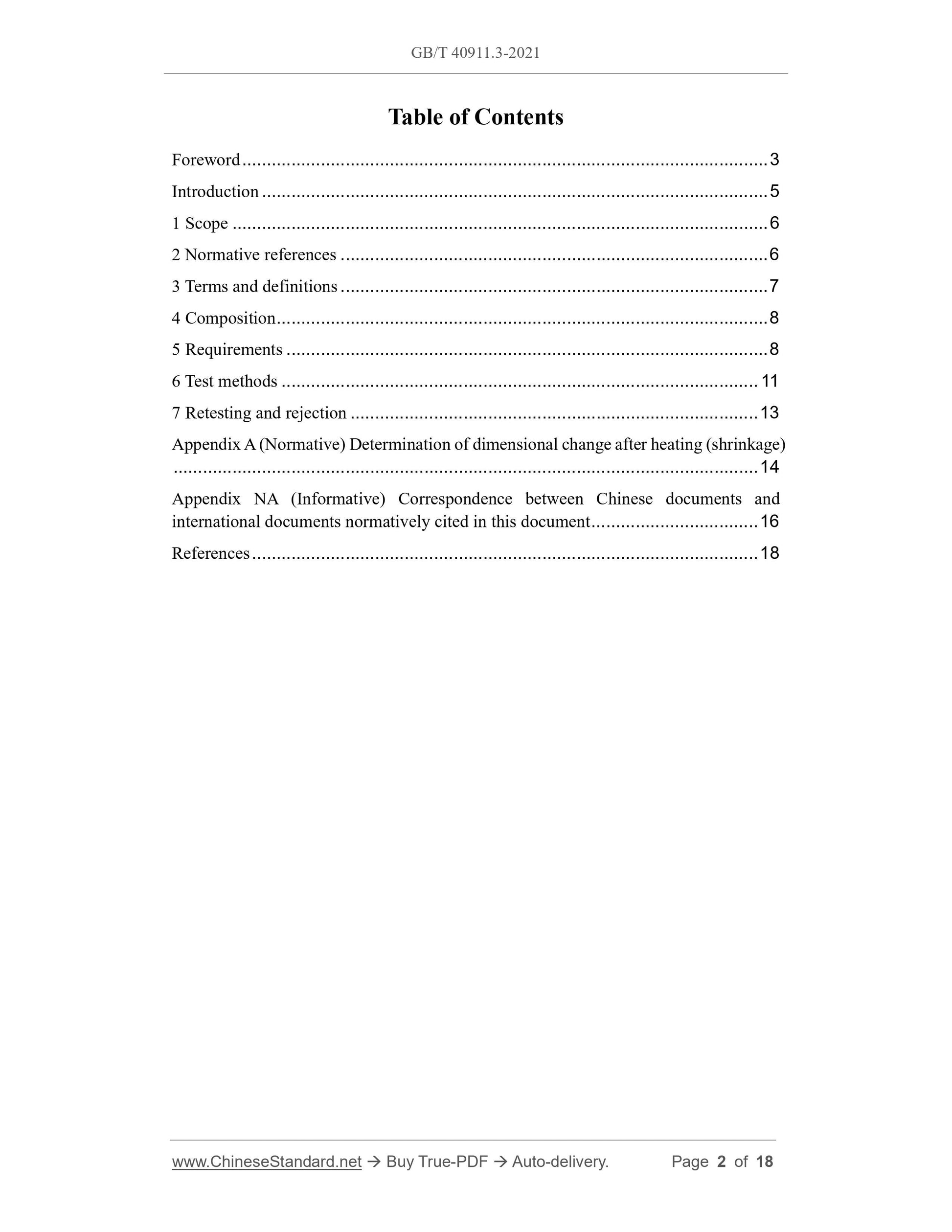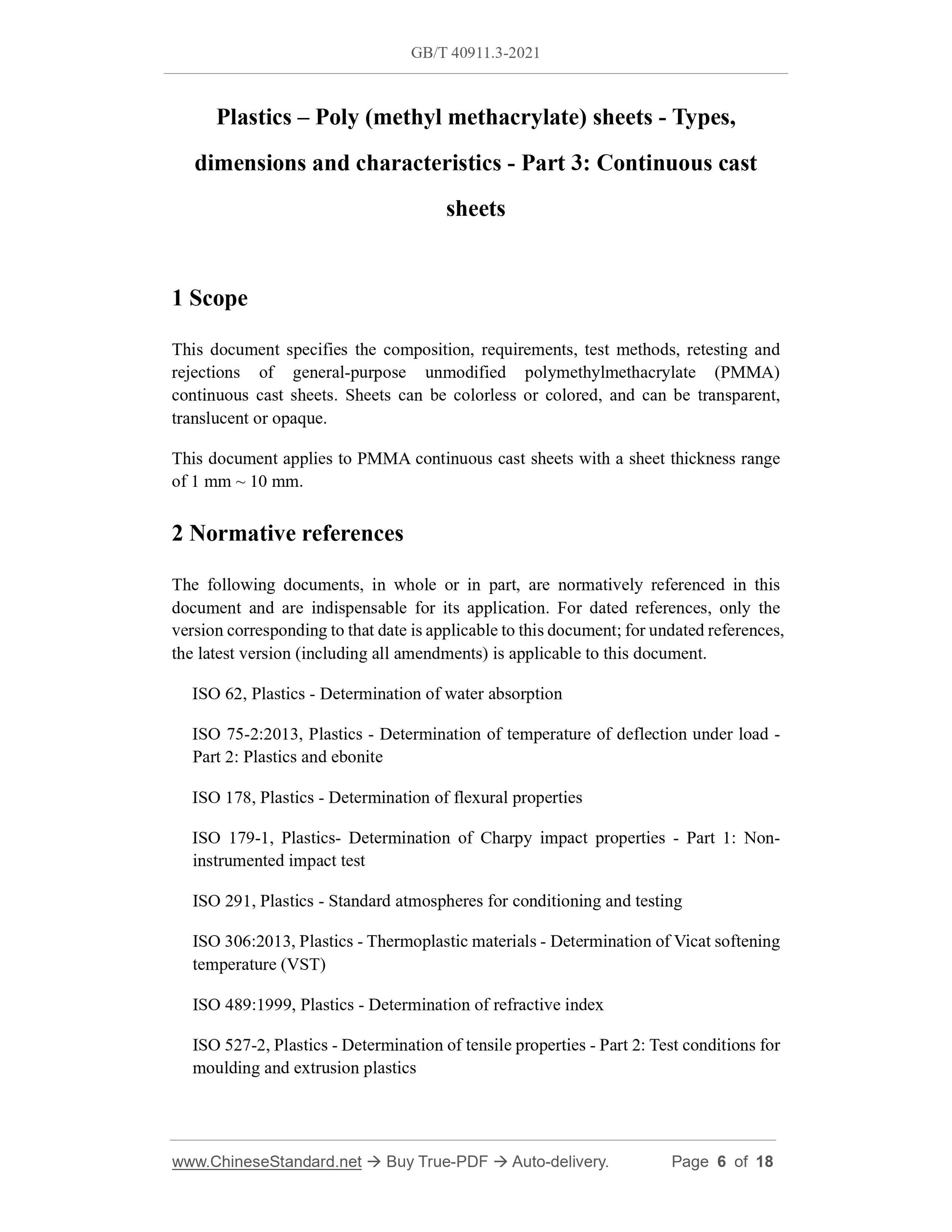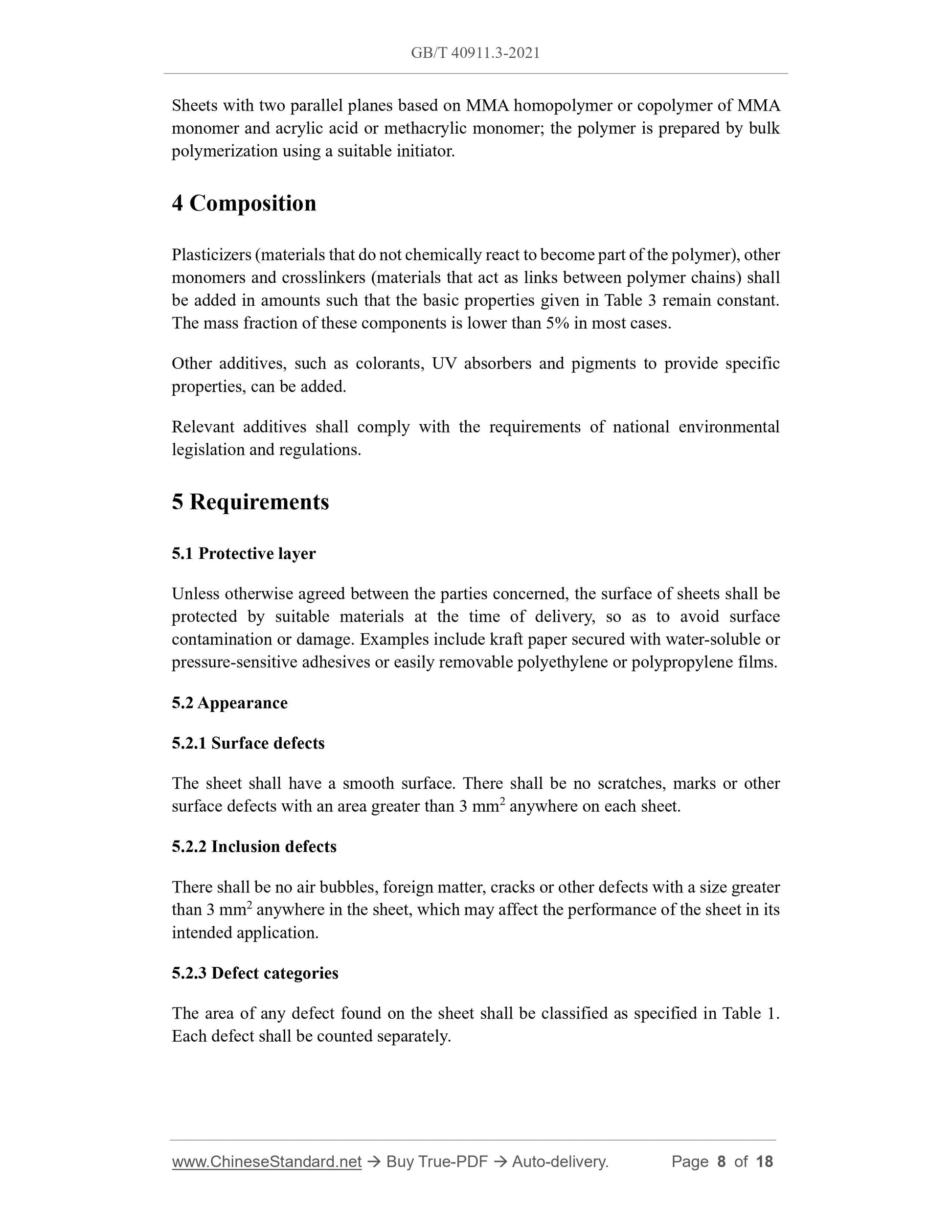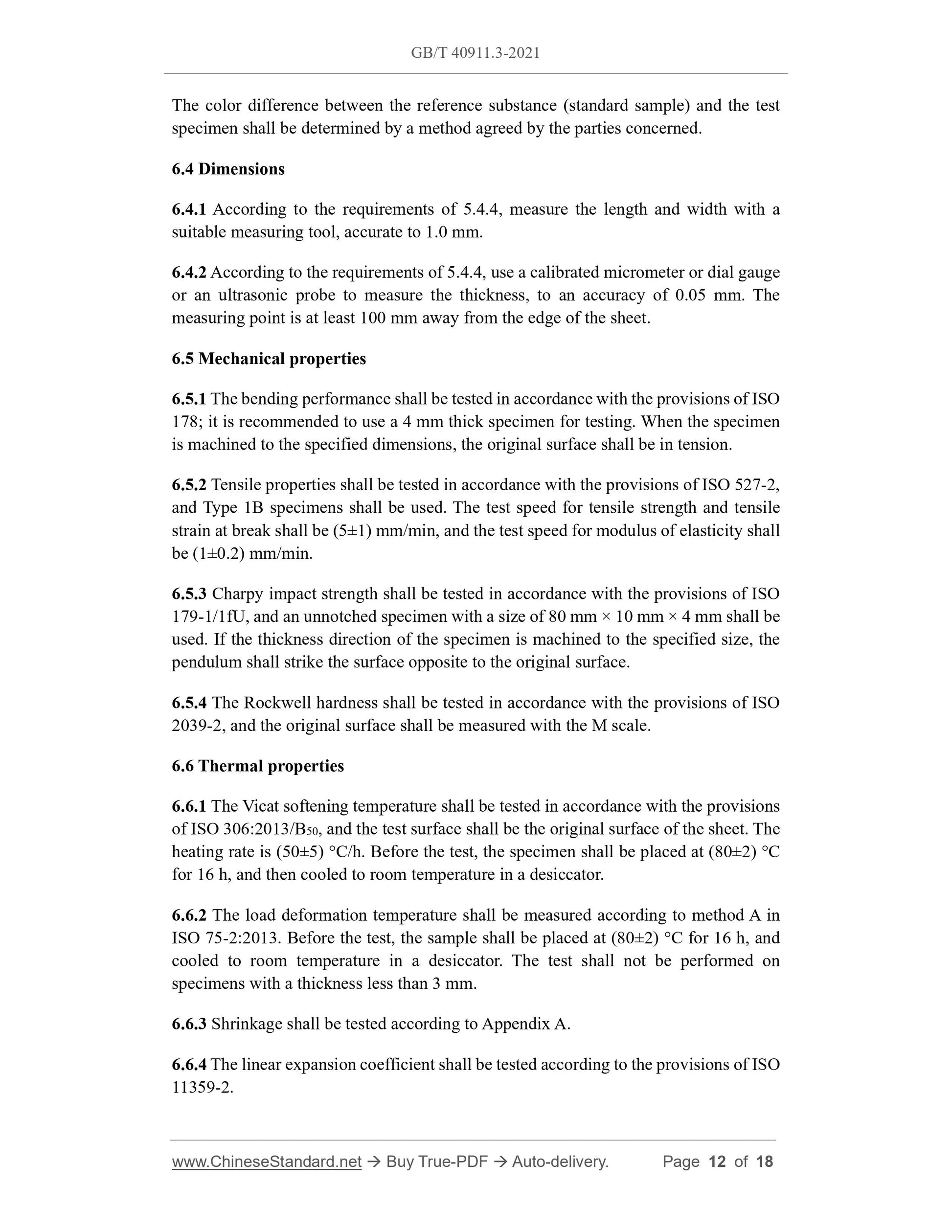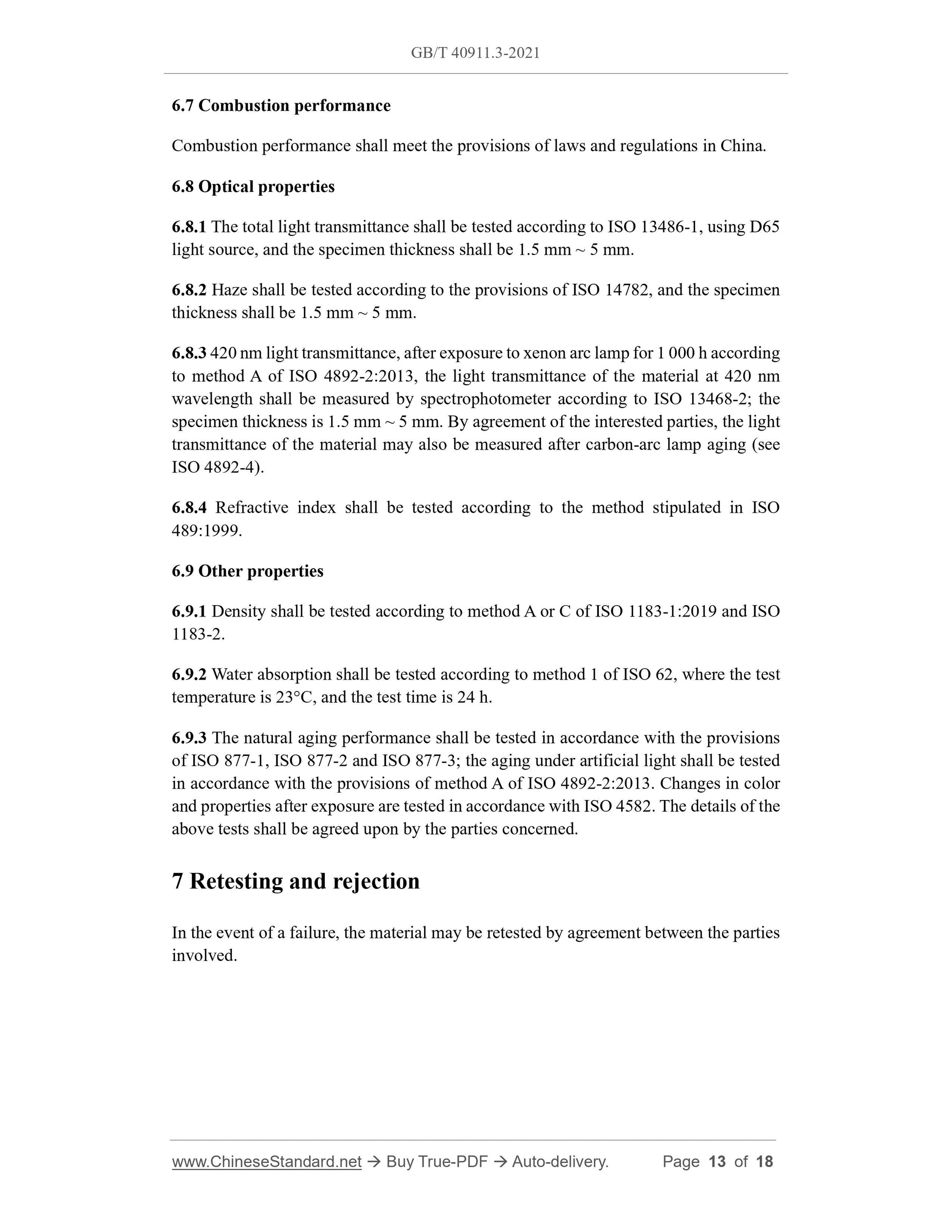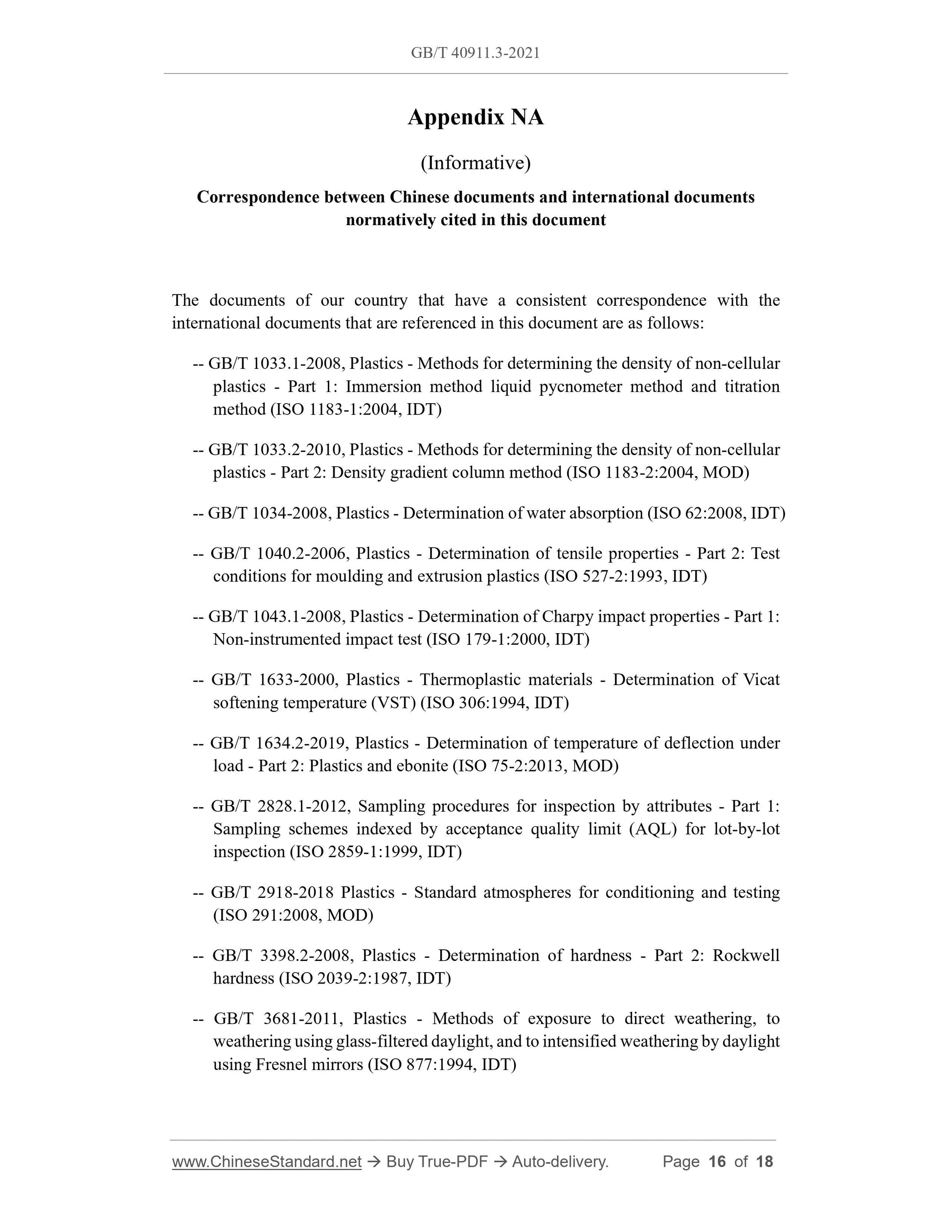1
/
of
7
PayPal, credit cards. Download editable-PDF & invoice in 1 second!
GB/T 40911.3-2021 English PDF (GBT40911.3-2021)
GB/T 40911.3-2021 English PDF (GBT40911.3-2021)
Regular price
$205.00 USD
Regular price
Sale price
$205.00 USD
Unit price
/
per
Shipping calculated at checkout.
Couldn't load pickup availability
Delivery: 3 seconds. Download true-PDF + Invoice.
Get QUOTATION in 1-minute: Click GB/T 40911.3-2021
Historical versions: GB/T 40911.3-2021
Preview True-PDF (Reload/Scroll if blank)
GB/T 40911.3-2021: Plastics -- Poly(methyl methacrylate) sheets -- Types, dimensions and characteristics -- Part 3: Continuous cast sheets
GB/T 40911.3-2021
GB
NATIONAL STANDARD OF THE
PEOPLE’S REPUBLIC OF CHINA
ICS 83.140.10
CCS G 33
GB/T 40911.3-2021 / ISO 7823-3:2021
Plastics – Poly (methyl methacrylate) sheets -
Types, dimensions and characteristics -
Part 3: Continuous cast sheets
(ISO 7823-3:2021, IDT)
ISSUED ON: NOVEMBER 26, 2021
IMPLEMENTED ON: JUNE 01, 2022
Issued by: State Administration for Market Regulation;
Standardization Administration of the People’s Republic of China.
Table of Contents
Foreword ... 3
Introduction ... 5
1 Scope ... 6
2 Normative references ... 6
3 Terms and definitions ... 7
4 Composition ... 8
5 Requirements ... 8
6 Test methods ... 11
7 Retesting and rejection ... 13
Appendix A (Normative) Determination of dimensional change after heating (shrinkage)
... 14
Appendix NA (Informative) Correspondence between Chinese documents and
international documents normatively cited in this document ... 16
References ... 18
Plastics – Poly (methyl methacrylate) sheets - Types,
dimensions and characteristics - Part 3: Continuous cast
sheets
1 Scope
This document specifies the composition, requirements, test methods, retesting and
rejections of general-purpose unmodified polymethylmethacrylate (PMMA)
continuous cast sheets. Sheets can be colorless or colored, and can be transparent,
translucent or opaque.
This document applies to PMMA continuous cast sheets with a sheet thickness range
of 1 mm ~ 10 mm.
2 Normative references
The following documents, in whole or in part, are normatively referenced in this
document and are indispensable for its application. For dated references, only the
version corresponding to that date is applicable to this document; for undated references,
the latest version (including all amendments) is applicable to this document.
ISO 62, Plastics - Determination of water absorption
ISO 75-2:2013, Plastics - Determination of temperature of deflection under load -
Part 2: Plastics and ebonite
ISO 178, Plastics - Determination of flexural properties
ISO 179-1, Plastics- Determination of Charpy impact properties - Part 1: Non-
instrumented impact test
ISO 291, Plastics - Standard atmospheres for conditioning and testing
ISO 306:2013, Plastics - Thermoplastic materials - Determination of Vicat softening
temperature (VST)
ISO 489:1999, Plastics - Determination of refractive index
ISO 527-2, Plastics - Determination of tensile properties - Part 2: Test conditions for
moulding and extrusion plastics
Sheets with two parallel planes based on MMA homopolymer or copolymer of MMA
monomer and acrylic acid or methacrylic monomer; the polymer is prepared by bulk
polymerization using a suitable initiator.
4 Composition
Plasticizers (materials that do not chemically react to become part of the polymer), other
monomers and crosslinkers (materials that act as links between polymer chains) shall
be added in amounts such that the basic properties given in Table 3 remain constant.
The mass fraction of these components is lower than 5% in most cases.
Other additives, such as colorants, UV absorbers and pigments to provide specific
properties, can be added.
Relevant additives shall comply with the requirements of national environmental
legislation and regulations.
5 Requirements
5.1 Protective layer
Unless otherwise agreed between the parties concerned, the surface of sheets shall be
protected by suitable materials at the time of delivery, so as to avoid surface
contamination or damage. Examples include kraft paper secured with water-soluble or
pressure-sensitive adhesives or easily removable polyethylene or polypropylene films.
5.2 Appearance
5.2.1 Surface defects
The sheet shall have a smooth surface. There shall be no scratches, marks or other
surface defects with an area greater than 3 mm2 anywhere on each sheet.
5.2.2 Inclusion defects
There shall be no air bubbles, foreign matter, cracks or other defects with a size greater
than 3 mm2 anywhere in the sheet, which may affect the performance of the sheet in its
intended application.
5.2.3 Defect categories
The area of any defect found on the sheet shall be classified as specified in Table 1.
Each defect shall be counted separately.
The color difference between the reference substance (standard sample) and the test
specimen shall be determined by a method agreed by the parties concerned.
6.4 Dimensions
6.4.1 According to the requirements of 5.4.4, measure the length and width with a
suitable measuring tool, accurate to 1.0 mm.
6.4.2 According to the requirements of 5.4.4, use a calibrated micrometer or dial gauge
or an ultrasonic probe to measure the thickness, to an accuracy of 0.05 mm. The
measuring point is at least 100 mm away from the edge of the sheet.
6.5 Mechanical properties
6.5.1 The bending performance shall be tested in accordance with the provisions of ISO
178; it is recommended to use a 4 mm thick specimen for testing. When the specimen
is machined to the specified dimensions, the original surface shall be in tension.
6.5.2 Tensile properties shall be tested in accordance with the provisions of ISO 527-2,
and Type 1B specimens shall be used. The test speed for tensile strength and tensile
strain at break shall be (5±1) mm/min, and the test speed for modulus of elasticity shall
be (1±0.2) mm/min.
6.5.3 Charpy impact strength shall be tested in accordance with the provisions of ISO
179-1/1fU, and an unnotched specimen with a size of 80 mm × 10 mm × 4 mm shall be
used. If the thickness direction of the specimen is machined to the specified size, the
pendulum shall strike the surface opposite to the original surface.
6.5.4 The Rockwell hardness shall be tested in accordance with the provisions of ISO
2039-2, and the original surface shall be measured with the M scale.
6.6 Thermal properties
6.6.1 The Vicat softening temperature shall be tested in accordance with the provisions
of ISO 306:2013/B50, and the test surface shall be the original surface of the sheet. The
heating rate is (50±5) °C/h. Before the test, the specimen shall be placed at (80±2) °C
for 16 h, and then cooled to room temperature in a desiccator.
6.6.2 The load deformation temperature shall be measured according to method A in
ISO 75-2:2013. Before the test, the sample shall be placed at (80±2) °C for 16 h, and
cooled to room temperature in a desiccator. The test shall not be performed on
specimens with a thickness less than 3 mm.
6.6.3 Shrinkage shall be tested according to Appendix A.
6.6.4 The linear expansion coefficient shall be tested according to the provisions of ISO
11359-2.
6.7 Combustion performance
Combustion performance shall meet the provisions of laws and regulations in China.
6.8 Optical properties
6.8.1 The total light transmittance shall be tested according to ISO 13486-1, using D65
light source, and the specimen thickness shall be 1.5 mm ~ 5 mm.
6.8.2 Haze shall be tested according to the provisions of ISO 14782, and the specimen
thickness shall be 1.5 mm ~ 5 mm.
6.8.3 420 nm light transmittance, after exposure to xenon arc lamp for 1 000 h according
to method A of ISO 4892-2:2013, the light transmittance of the material at 420 nm
wavelength shall be measured by spectrophotometer according to ISO 13468-2; the
specimen thickness is 1.5 mm ~ 5 mm. By agreement of the interested parties, the light
transmittance of the material may also be measured after carbon-arc lamp aging (see
Get QUOTATION in 1-minute: Click GB/T 40911.3-2021
Historical versions: GB/T 40911.3-2021
Preview True-PDF (Reload/Scroll if blank)
GB/T 40911.3-2021: Plastics -- Poly(methyl methacrylate) sheets -- Types, dimensions and characteristics -- Part 3: Continuous cast sheets
GB/T 40911.3-2021
GB
NATIONAL STANDARD OF THE
PEOPLE’S REPUBLIC OF CHINA
ICS 83.140.10
CCS G 33
GB/T 40911.3-2021 / ISO 7823-3:2021
Plastics – Poly (methyl methacrylate) sheets -
Types, dimensions and characteristics -
Part 3: Continuous cast sheets
(ISO 7823-3:2021, IDT)
ISSUED ON: NOVEMBER 26, 2021
IMPLEMENTED ON: JUNE 01, 2022
Issued by: State Administration for Market Regulation;
Standardization Administration of the People’s Republic of China.
Table of Contents
Foreword ... 3
Introduction ... 5
1 Scope ... 6
2 Normative references ... 6
3 Terms and definitions ... 7
4 Composition ... 8
5 Requirements ... 8
6 Test methods ... 11
7 Retesting and rejection ... 13
Appendix A (Normative) Determination of dimensional change after heating (shrinkage)
... 14
Appendix NA (Informative) Correspondence between Chinese documents and
international documents normatively cited in this document ... 16
References ... 18
Plastics – Poly (methyl methacrylate) sheets - Types,
dimensions and characteristics - Part 3: Continuous cast
sheets
1 Scope
This document specifies the composition, requirements, test methods, retesting and
rejections of general-purpose unmodified polymethylmethacrylate (PMMA)
continuous cast sheets. Sheets can be colorless or colored, and can be transparent,
translucent or opaque.
This document applies to PMMA continuous cast sheets with a sheet thickness range
of 1 mm ~ 10 mm.
2 Normative references
The following documents, in whole or in part, are normatively referenced in this
document and are indispensable for its application. For dated references, only the
version corresponding to that date is applicable to this document; for undated references,
the latest version (including all amendments) is applicable to this document.
ISO 62, Plastics - Determination of water absorption
ISO 75-2:2013, Plastics - Determination of temperature of deflection under load -
Part 2: Plastics and ebonite
ISO 178, Plastics - Determination of flexural properties
ISO 179-1, Plastics- Determination of Charpy impact properties - Part 1: Non-
instrumented impact test
ISO 291, Plastics - Standard atmospheres for conditioning and testing
ISO 306:2013, Plastics - Thermoplastic materials - Determination of Vicat softening
temperature (VST)
ISO 489:1999, Plastics - Determination of refractive index
ISO 527-2, Plastics - Determination of tensile properties - Part 2: Test conditions for
moulding and extrusion plastics
Sheets with two parallel planes based on MMA homopolymer or copolymer of MMA
monomer and acrylic acid or methacrylic monomer; the polymer is prepared by bulk
polymerization using a suitable initiator.
4 Composition
Plasticizers (materials that do not chemically react to become part of the polymer), other
monomers and crosslinkers (materials that act as links between polymer chains) shall
be added in amounts such that the basic properties given in Table 3 remain constant.
The mass fraction of these components is lower than 5% in most cases.
Other additives, such as colorants, UV absorbers and pigments to provide specific
properties, can be added.
Relevant additives shall comply with the requirements of national environmental
legislation and regulations.
5 Requirements
5.1 Protective layer
Unless otherwise agreed between the parties concerned, the surface of sheets shall be
protected by suitable materials at the time of delivery, so as to avoid surface
contamination or damage. Examples include kraft paper secured with water-soluble or
pressure-sensitive adhesives or easily removable polyethylene or polypropylene films.
5.2 Appearance
5.2.1 Surface defects
The sheet shall have a smooth surface. There shall be no scratches, marks or other
surface defects with an area greater than 3 mm2 anywhere on each sheet.
5.2.2 Inclusion defects
There shall be no air bubbles, foreign matter, cracks or other defects with a size greater
than 3 mm2 anywhere in the sheet, which may affect the performance of the sheet in its
intended application.
5.2.3 Defect categories
The area of any defect found on the sheet shall be classified as specified in Table 1.
Each defect shall be counted separately.
The color difference between the reference substance (standard sample) and the test
specimen shall be determined by a method agreed by the parties concerned.
6.4 Dimensions
6.4.1 According to the requirements of 5.4.4, measure the length and width with a
suitable measuring tool, accurate to 1.0 mm.
6.4.2 According to the requirements of 5.4.4, use a calibrated micrometer or dial gauge
or an ultrasonic probe to measure the thickness, to an accuracy of 0.05 mm. The
measuring point is at least 100 mm away from the edge of the sheet.
6.5 Mechanical properties
6.5.1 The bending performance shall be tested in accordance with the provisions of ISO
178; it is recommended to use a 4 mm thick specimen for testing. When the specimen
is machined to the specified dimensions, the original surface shall be in tension.
6.5.2 Tensile properties shall be tested in accordance with the provisions of ISO 527-2,
and Type 1B specimens shall be used. The test speed for tensile strength and tensile
strain at break shall be (5±1) mm/min, and the test speed for modulus of elasticity shall
be (1±0.2) mm/min.
6.5.3 Charpy impact strength shall be tested in accordance with the provisions of ISO
179-1/1fU, and an unnotched specimen with a size of 80 mm × 10 mm × 4 mm shall be
used. If the thickness direction of the specimen is machined to the specified size, the
pendulum shall strike the surface opposite to the original surface.
6.5.4 The Rockwell hardness shall be tested in accordance with the provisions of ISO
2039-2, and the original surface shall be measured with the M scale.
6.6 Thermal properties
6.6.1 The Vicat softening temperature shall be tested in accordance with the provisions
of ISO 306:2013/B50, and the test surface shall be the original surface of the sheet. The
heating rate is (50±5) °C/h. Before the test, the specimen shall be placed at (80±2) °C
for 16 h, and then cooled to room temperature in a desiccator.
6.6.2 The load deformation temperature shall be measured according to method A in
ISO 75-2:2013. Before the test, the sample shall be placed at (80±2) °C for 16 h, and
cooled to room temperature in a desiccator. The test shall not be performed on
specimens with a thickness less than 3 mm.
6.6.3 Shrinkage shall be tested according to Appendix A.
6.6.4 The linear expansion coefficient shall be tested according to the provisions of ISO
11359-2.
6.7 Combustion performance
Combustion performance shall meet the provisions of laws and regulations in China.
6.8 Optical properties
6.8.1 The total light transmittance shall be tested according to ISO 13486-1, using D65
light source, and the specimen thickness shall be 1.5 mm ~ 5 mm.
6.8.2 Haze shall be tested according to the provisions of ISO 14782, and the specimen
thickness shall be 1.5 mm ~ 5 mm.
6.8.3 420 nm light transmittance, after exposure to xenon arc lamp for 1 000 h according
to method A of ISO 4892-2:2013, the light transmittance of the material at 420 nm
wavelength shall be measured by spectrophotometer according to ISO 13468-2; the
specimen thickness is 1.5 mm ~ 5 mm. By agreement of the interested parties, the light
transmittance of the material may also be measured after carbon-arc lamp aging (see
Share
